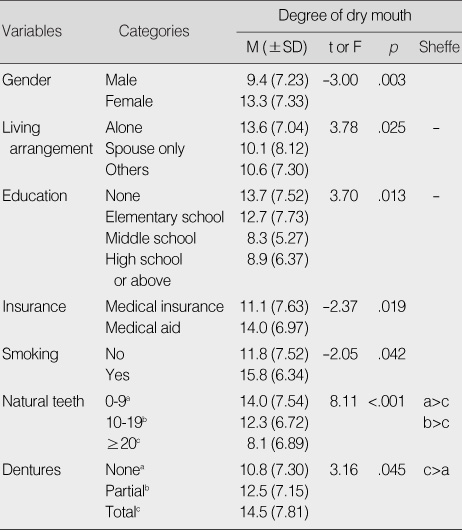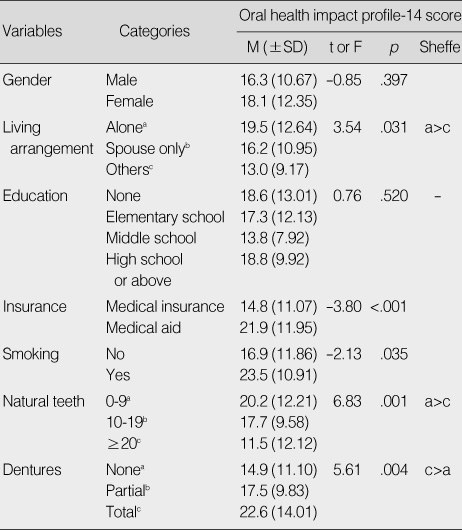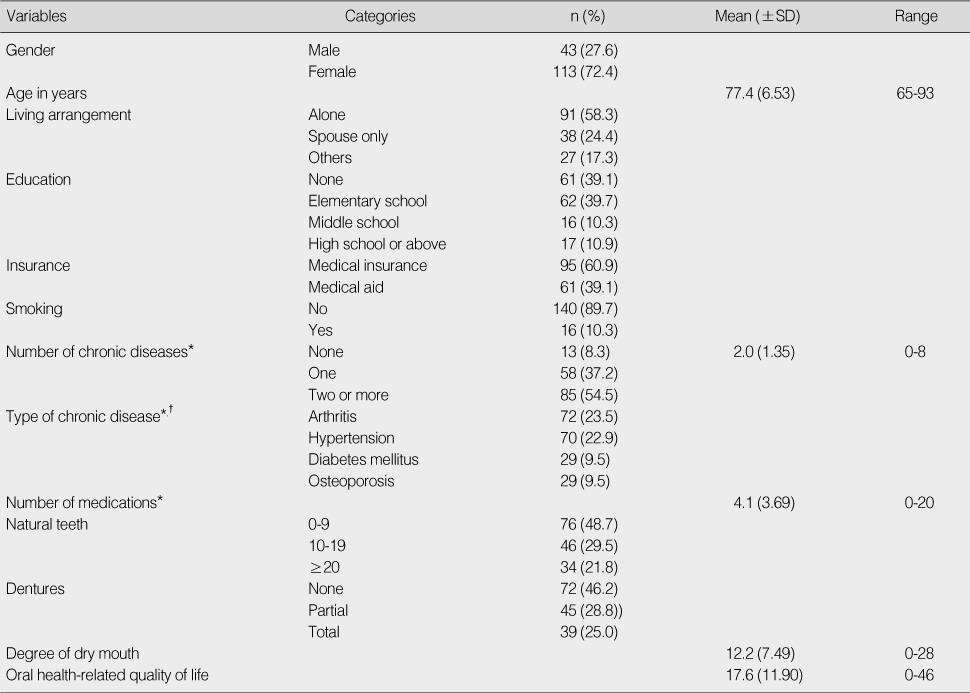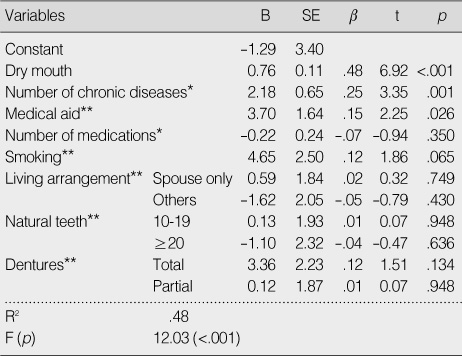Articles
- Page Path
- HOME > J Korean Acad Nurs > Volume 40(5); 2010 > Article
-
Original Article
- Degree of Dry Mouth and Factors Influencing Oral Health-related Quality of Life for Community-Dwelling Elders
- Myung Sook Park, Se Ang Ryu
-
Journal of Korean Academy of Nursing 2010;40(5):747-755.
DOI: https://doi.org/10.4040/jkan.2010.40.5.747
Published online: October 31, 2010
1Assistant Professor, Department of Nursing, Sun Moon University, Asan, Korea.
2Assistant Professor, Department of Nursing, Dongshin University, Naju, Korea.
- Address reprint requests to: Ryu, Se Ang. Department of Nursing, Dongshin University, 252 Daeho-dong, Naju 520-714, Korea. Tel: 82-61-330-3585, Fax: 82-61-330-3580, saryu@dsu.ac.kr
Copyright © 2010 Korean Society of Nursing Science
Abstract
-
Purpose
- This study was conducted to investigate the degree of dry mouth and oral health-related quality of life and to identify factors contributing to oral health-related quality of life for community-dwelling elders.
-
Methods
- A descriptive correlational study design was used. Participants were 156 older adults from two senior welfare centers. Data were collected on February 21, 22 and 29, 30, 2009 using structured questionnaires. Enter type multiple regression analysis was used to identify factors influencing oral health-related quality of life according to general and oral health characteristics.
-
Results
- There were significant differences in oral health-related quality of life according to living arrangement, insurance, smoking, number of natural teeth, and denture type. The oral health-related quality of life had significant correlations with the number of chronic disease, number of medications, and dry mouth. Factors influencing oral health-related quality of life for community-dwelling older adults were dry mouth, number of chronic disease, and medical aid, which explained about 47.9% of total variance.
-
Conclusion
- These results indicate that in order to promote oral health-related quality of life for older adults, prevention or management of chronic diseases as well as oral health and dry mouth are needed for this population, and especially economically poor elders.
- 1. Cassolato SF, Turnbull RS. Xerostomia: Clinical aspects and treatment. Gerodontology. 2003;20:64–77.ArticlePubMed
- 2. Ciancio SG. Medications' impact on oral health. Journal of the American Dental Association. 2004;135:1440–1448.ArticlePubMed
- 3. Coleman P. Improving oral health care for the frail elderly: A review of widespread problems and best practices. Geriatric Nursing. 2002;23:189–199.ArticlePubMed
- 4. Coleman P. Opportunities for nursing-dental collaboration: Addressing oral health needs among the elderly. Nursing Outlook. 2005;53:33–39.ArticlePubMed
- 5. Field EA, Fear S, Higham SM, Ireland RS, Rostron J, Willetts RM, et al. Age and medication are significant risk factors for xerostomia in an English population, attending general dental practice. Gerodontology. 2001;18:21–24.ArticlePubMed
- 6. Fox PC. Management of dry mouth. Dental Clinics of North America. 1997;41:863–875.ArticlePubMed
- 7. Gerdin EW, Einarson S, Jonsson M, Aronsson K, Johansson I. Impact of dry mouth conditions on oral health-related quality of life in older people. Gerodontology. 2005;22:219–226.ArticlePubMed
- 8. Gonsalves WC, Wrightson AS, Henry RG. Common oral conditions in older persons. American Family Physician. 2008;78:845–852.PubMed
- 9. Guggenheimer J, Moore PA. Xerostomia: Etiology, recognition and treatment. Journal of the American Dental Association. 2003;134:61–69.PubMed
- 10. Ikebe K, Matsuda K, Morii K, Wada M, Hazeyama T, Nokubi T, et al. Impact of dry mouth and hyposalivation on oral health-related quality of life of elderly Japanese. Oral Surgery, Oral Medicine, Oral Pathology, Oral Radiology, and Endodontics. 2006;103:216–222.ArticlePubMed
- 11. Jang JH, Baik SH, Kim AJ, Jung SH, Kim OS, Kim SH. The effect of xerostomia on perceived oral health among elderly people wearing dentures. Journal of Korean Academy of Oral Health. 2006;30:438–446.
- 12. Jang MS, Kim HY, Shim YS, Rhyu IC, Han SB, Chung CP, et al. Association of self-reported periodontal health status and oral health related quality of life. Journal of Korean Academy of Periodontology. 2006;36:591–599.
- 13. Jung Y, Shin D. Oral health, nutrition, and oral health related quality of life among Korean older adults. Journal of Gerontological Nursing. 2008;34(10):28–35.Article
- 14. Kim B, Yun G, Seok S. Effects of individual reminiscence therapy on older adults' depression, morale and quality of life. Journal of Korean Academy of Nursing. 2006;36:813–820.ArticlePubMedPDF
- 15. 2008 Statistics on the aged. Korea National Statistical Office. 2008;Retrieved October 27, 2008. from http://www.w3.org/1999/xlink" xlink:href="http://www.kostat.go.kr/eboard_faq/BoardAction.do?method=view&board_id=106&seq=217&num=217&parent_num=0&page=1&sdate=&edate=&search_mode=s_title&keyword=2008%20Statistics%20on%20the%20Ag&catgrp=eng2009&catid1=g01&catid2=g01b&catid3=&catid4=.
- 16. Lee J. Dry mouth in the Korean elderly: Association factors, and impact on oral health related quality of life. 2006;Seoul, Seoul National University. Unpublished master' thesis.
- 17. Lee M, Kim S, Yang J, Oh J, Kim D. Validity and reliability of the oral health impact profile in elderly Korean 65+. Journal of Korean Academy of Oral Health. 2005;29:210–221.
- 18. Locker D. Dental status, xerostomia and the oral health related quality of life of an elderly institutionalized population. Special Care in Dentistry. 2003;23:86–93.ArticlePubMed
- 19. Matear DW, Locker D, Stephens M, Lawrence HP. Associations between xerostomia and health status indicators in the elderly. The Journal of the Royal Society for the Promotion of Health. 2006;126:79–85.ArticlePubMedPDF
- 20. Park J. The effects of an elderly health promotion on health promotion lifestyle, health status, quality of life in the elderly. Journal of Korean Academy of Nursing. 2004;34:1194–1204.PubMed
- 21. Petersen PE, Yamamoto T. Improving the oral health of older people: The approach of the WHO global oral health programme. Community Dentistry and Oral Epidemiology. 2005;33:81–92.ArticlePubMed
- 22. Slade GD, Spencer AJ. Social impact of oral conditions among older adults. Australian Dental Journal. 1994;39:358–364.ArticlePubMed
- 23. So JS. Prevalence and severity of dry mouth in the Korean elderly. 2005;Seoul, Seoul National University. Unpublished doctoral dissertation.
- 24. 2004 A national survey on the living status and welfare needs of the aged. The Korea Institute for Health and Social Affairs. 2004;Retrieved February 18, 2009. from http://www.mw.go.kr/front/jb/sjb030301vw.jsp?PAR_MENU_ID=03&MENU_ID=03030301&BOARD_ID=1003&BOARD_FLAG=03&CONT_SEQ=32392&page=1.
- 25. Thomson WM, Chalmers JM, Spencer AJ, Williams SM. The xerostomia inventory: A multi-item approach to measuring dry mouth. Community Dental Health. 1999;16:12–17.PubMed
- 26. Turner MD, Ship JA. Dry mouth and its effects on the oral health of elderly people. Journal of the American Dental Association. 2007;138:15S–20S.PubMed
- 27. Oral health in America: A report of the surgeon general. U.S. Department of Health and Human Services. 2000;05 25 Retrieved March 15, 2010. from http://silk.nih.gov/public/hck1ocv.@www.surgeon.fullrpt.pdf.
REFERENCES



Figure & Data
REFERENCES
Citations

- The Impact of Toothbrushing Timing on Perceived Oral Health Status among Older Adults
Ji-Young Son
Journal of Dental Hygiene Science.2025; 25(1): 19. CrossRef - Factors Affecting Oral Health-Related Quality of Life in Community-Dwelling Older Adults Living Alone: An Analysis of Data from the Ninth Korean Longitudinal Study of Aging
Hyuk Joon Kim, Hye Young Kim, Byeong Kwan Kim
Journal of Korean Academy of Fundamentals of Nursing.2024; 31(4): 524. CrossRef - Quality Characteristics of Functional Yanggaeng Supplemented with Bamboo Leaf Powder
Hyemi Kang, Jin Ju Baek, Soo In Ryu, Jean Kyung Paik
Journal of the Korean Society of Food Science and Nutrition.2023; 52(9): 879. CrossRef - Oral Health Behaviors and Oral Health-Related Quality of Life Among Dental Patients in China: A Cross-Sectional Study
Ran An, Siyu Li, Qianqian Li, Yuan Luo, Zitong Wu, Meizi Liu, Wenfeng Chen
Patient Preference and Adherence.2022; Volume 16: 3045. CrossRef - Impact of Oral Health Factors on Quality of Life of Geriatric Population - A Systematic Review
Shalu Rai, Deepankar Misra, Akansha Misra, Ankit Jain, Suman Bisla
Journal of Indian Academy of Oral Medicine and Radiology.2021; 33(4): 453. CrossRef - Nutrient intakes and medication use in elderly individuals with and without dry mouths
Kyung Ah Lee, Jung-Chul Park, Yoo Kyoung Park
Nutrition Research and Practice.2020; 14(2): 143. CrossRef - The Influence of Oral Health Factors on the Quality of Life in Older People: A Systematic Review
Liza J M van de Rijt, Celine C Stoop, Roxane A F Weijenberg, Ralph de Vries, Alexandra R Feast, Elizabeth L Sampson, Frank Lobbezoo, Patricia C Heyn
The Gerontologist.2020; 60(5): e378. CrossRef - The Analysis of Research Trends of Elderly in the Dental Hygiene Discipline
Hwa-Soo Goong, Kawoun Seo
Journal of Dental Hygiene Science.2018; 18(4): 201. CrossRef - Prevalence and influencing factors of dysphagia in elderly patients
Hyo-Jin Son, Yu-Mi Park, Sun-Young Yim, Yu-Ri Heo, Mee-Kyoung Son
Oral Biology Research.2018; 42(4): 208. CrossRef - The effect of oral exercise on oral health and oral health related quality of life in the elderly people
Eun-kyong Kim, Min-Seon Kim, Hee-Kyung Lee
Journal of Korean society of Dental Hygiene.2016; 16(1): 103. CrossRef - Oral health-related quality of life in social welfare workers according to oral health status
Ae-Hee Song, Hye-Jeong Youn, Sun-A Lim
Journal of Korean society of Dental Hygiene.2016; 16(2): 277. CrossRef - Correlation among Halitosis, Xerostomia and Stress in Adults
Ki-Eun Kim, Ji-Hyoung Han
Journal of dental hygiene science.2016; 16(5): 370. CrossRef - Comparison of Effects according to Type of Oral Exercise Program for Elderly in Gangneung City
Sue-Hyang Lee, Jean-A Ryu, Ha-Eun Yu, Jin-Hee Lee, Sun-Jung Shin
Journal of Dental Hygiene Science.2016; 16(6): 424. CrossRef - Dental Utilization Associated Factors among Elderly
Eunsuk Ahn, Ji-Min Hwang, Myong-Suk Shin
Journal of dental hygiene science.2015; 15(1): 60. CrossRef - Relationship of Depression, Stress, and Self-Esteem with Oral Health-Related Quality of Life of Middle-Aged Women
Hyun-Jung Kwon, Mi-Sook Yoon
Journal of dental hygiene science.2015; 15(6): 825. CrossRef - Associated factors of self-reported dry mouth in adults
Sun-Sook Kim, Hye-Jeong Youn
Journal of Korean society of Dental Hygiene.2015; 15(1): 55. CrossRef - Oral Health-Related Quality of Life of the Elderly under Visiting Health Care
Keun-Yoo Lee, Young-Sik Cho, Soon-Ryun Lim
Journal of dental hygiene science.2015; 15(3): 325. CrossRef - Related factors of oral health-related quality of life in the severely disabled people
Mi-Jeong Bae, Se-Hyun Hwang, Sung-Ae Kim, Ji-Young Lee, Jung-Ae Yoon, Jung-Hyun Park, Sang-Hwa Urm, Byeng-Chul Yu
Journal of Korean society of Dental Hygiene.2015; 15(3): 461. CrossRef - The mediation effects of psychological factors in the relationship between mouth dryness and oral health related quality of life
Hee-Jung Park, Minsung Sohn, Jun Hyup Lee, Bo-Hyoung Jin, Sophia Lee, Tae-Il Kim
Journal of Korean Academy of Oral Health.2014; 38(1): 31. CrossRef - Subjective Xerostomia and Jaw Functional Limitation Related Quality of Life of the Elderly
Mee-Kyung Kim, Hyang-Mi Jung, Gong-Ju Park
The Korean Journal of Health Service Management.2014; 8(1): 87. CrossRef - Factors Associated With Oral Health Related-quality of Life in Elderly Persons: Applying Andersen's Model
Young-Hee Yom, Jung-Hee Han
Journal of Korean Academy of Fundamentals of Nursing.2014; 21(1): 18. CrossRef - Availability of Diagnosis of Yin-deficiency in Elderly People with Xerostomia and Factors Influencing Subjective Oral Dryness: A Prospective Cross-sectional Study
Juyeon Kim, Jinsung Kim, Jaewoo Park, Bongha Ryu
Journal of Korean Medicine.2013; 34(3): 13. CrossRef - The influence of stress on oral mucosal disease, dry mouth and stress symptoms in adults
Min-Hee Hong
Journal of Korean society of Dental Hygiene.2013; 13(4): 589. CrossRef - The Impact of Oral Health Impact Profile(OHIP-14) of Subjectively Reported Oral Status in the Elderly
Eun-Hee Kim, Min-Kyoung Park, In-Young Ku, Seon-Jeong Moon, Seung-Hyeon Kim
Journal of the Korea Academia-Industrial cooperation Society.2013; 14(9): 4349. CrossRef - Effects of Oral Health Impact Profile (OHIP) on Depression and Quality of Life among Community-dwelling Korean Elderly Persons
Hung Sa Lee, Chunmi Kim
Journal of Korean Academy of Community Health Nursing.2012; 23(3): 338. CrossRef - The Effects of Oral Function Improving Exercise on the UWS, Oral function and OHIP in Elderly
Soon-Ok Yang, Geumhee Jeong, Shin-Jeong Kim, Kyongwon Kim, Seung Hee Lee, Sooyoung Saung, Sunghee Baik
Journal of Korean Public Health Nursing.2012; 26(3): 478. CrossRef - The Factors of Oral Health Impact profile of workers -Industrial workers in Gyeong-Nam province-
Jeong-Dan Cha, Kyeung-Ae Jang
Journal of the Korea Academia-Industrial cooperation Society.2012; 13(10): 4604. CrossRef - Adults'self-reported of dry mouth and it's associated impact factors
Hee-Jung Park, Youn-Soo Shim
Journal of Korean society of Dental Hygiene.2012; 12(5): 973. CrossRef - The Effects of Oral Care Education on Caregivers' Knowledge, Attitude, & Behavior toward Oral Hygiene for Elderly Residents in a Nursing Home
Myung Sook Park, Smi Choi-Kwon
Journal of Korean Academy of Nursing.2011; 41(5): 684. CrossRef
General and Oral Health Characteristics (N=156)
*Duplicated selection possible; †Ranked top 4.
Differences in Degree of Dry Mouth according to General and Oral Health Characteristics (N=156)
Differences in Oral Health-related Quality of Life according to General and Oral Health Characteristics (N=156)
Correlations of Oral Health-related Quality of Life with General and Oral Health Characteristics (N=156)
*Duplicated selection possible.
Factors Influencing Oral Health related Quality of Life (N=156)
*Duplicated selection possible; **Medical aid, smoking, living arrangement, natural teeth, and dentures were entered as categorical variables with reference as medical insurance, no smoking, living alone, natural teeth ≤9, and no dentures, respectively.
*Duplicated selection possible; †Ranked top 4.
*Duplicated selection possible.
*Duplicated selection possible; **Medical aid, smoking, living arrangement, natural teeth, and dentures were entered as categorical variables with reference as medical insurance, no smoking, living alone, natural teeth ≤9, and no dentures, respectively.
 KSNS
KSNS
 E-SUBMISSION
E-SUBMISSION


 Cite
Cite

